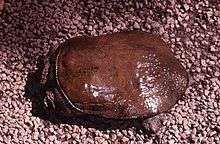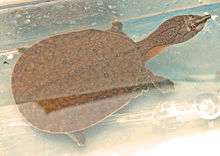Wattle-necked softshell turtle
| Wattle-necked softshell turtle | |
|---|---|
 | |
| Scientific classification | |
| Kingdom: | Animalia |
| Phylum: | Chordata |
| Class: | Reptilia |
| Order: | Testudines |
| Suborder: | Cryptodira |
| Family: | Trionychidae |
| Subfamily: | Trionychinae |
| Genus: | Palea Meylan, 1987 [2] |
| Species: | P. steindachneri |
| Binomial name | |
| Palea steindachneri (Siebenrock, 1906)[2] | |
| Synonyms[3] | |
| |
The wattle-necked softshell turtle (Palea steindachneri ), also commonly known as Steindachner's soft-shelled turtle,[4] is an endangered Asian species of softshell turtle and the only member of the genus Palea.[2] The shell of females of this freshwater turtle reaches up to 44.5 cm (17.5 in) in length, while it reaches up to 36 cm (14 in) in males, which however have a longer tail than the females.[5]
Etymology
The specific name, steindachneri, is in honor of Austrian herpetologist Franz Steindachner.[4]
Distribution
P. steindachneri is native to southeastern China (Guangdong, Guangxi, Guizhou, Hainan, Yunnan), Laos, and Vietnam, but has also been introduced to Hawaii and Mauritius.[2]
Threats
P. steindachneri is endangered by poaching for human consumption.[1] Although pressure on the wild population continues, several thousand are hatched and raised each year in turtle farms in China and Vietnam for food and traditional medicine.[6][7]
References
- 1 2 Asian Turtle Trade Working Group (2000). Palea steindachneri. In: IUCN 2012. IUCN Red List of Threatened Species. Version 2012.2.
- 1 2 3 4 Rhodin, Anders G.J.; van Dijk, Peter Paul; Inverson, John B.; Shaffer, H. Bradley; Roger, Bour (2011-12-31). "Turtles of the world, 2011 update: Annotated checklist of taxonomy, synonymy, distribution and conservation status". Chelonian Research Monographs. 5. Archived from the original (PDF) on 2012-01-22.
- ↑ Fritz, Uwe; Havaš, Peter (2007). "Checklist of Chelonians of the World". Vertebrate Zoology. 57 (2). Archived from the original (PDF) on 2010-12-17.
- 1 2 Beolens B, Watkins M, Grayson M (2011) The Eponym Dictionary of Reptiles. Baltimore: Johns Hopkins University Press. xiii + 296 pp. ISBN 978-1-4214-0135-5. (Palea steindachneri, p. 252).
- ↑ Ernst,C.H.; and J.E. Lovich (2009). Turtles of the United States and Canada (2 ed.). p. 636. ISBN 978-0-8018-9121-2.
- ↑ Dharmananda, Subhuti, Endangered species issues affecting turtles and tortoises in Chinese medicine, Institute for Traditional Medicine, Portland, Oregon
- ↑ "Raising trionychid turtles in Yen Bai", Vietnam in photos, 2013-02-17
Further reading
- Meylan PA (1987). "The Phylogenetic Relationships of Soft-shelled Turtles (Family Trionychidae)". Bull. American Mus. Nat. Hist. 186 (1): 1-100. (Palea, new genus, p. 94).
- Siebenrock F (1906). "Zur Kenntnis der Schildkrötenfauna der Insel Hainan ". Zoologischer Anzeiger 30: 578-586. (Trionyx steindachneri, new species, pp. 579–581). (in German).
| Wikispecies has information related to Palea steindachneri |

